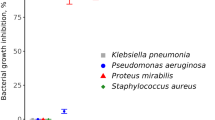Abstract
A total of 978 strains ofBacteroides andFusobacterium were tested for beta-lactamase production by a disk test (Cefinase) and a microtiter nitrocefin assay. In 83 % of strains both tests were positive and in 14.8 % both were negative. In 1.7 % of strains the disk test was positive and the microtiter test negative, and in 0.4 % the disk test negative but the microtiter test positive. The disk test was less discriminatory in detecting amoxicillin-resistant strains. The microtiter test was less sensitive than the disk test, but more discriminatory if results were read within 1 h forFusobacterium spp., within 8 h for theBacteroides fragilis group, and within 2 h for otherBacteroides spp. Neither test should be used clinically at present.
Similar content being viewed by others
References
Barlam T, Neu HC Pyridinium 2-azo-p-dimethyl-aniline chromophore, a chromogenic reagent for beta-lactamase testing compared to nitrocefin. European Journal of Clinical Microbiology 1984, 3: 185–189.
Bourgault, AM, Rosenblatt JE Characterization of anaerobic gram-negative bacilli by using rapid slide tests for β-lactamase production. Journal of Clinical Microbiology 1979, 9: 654–656.
Chen KCS, Knapp JS, Holmes KK Rapid, inexpensive method for specific detection of microbial β-lactamases by detection of fluorescent end-products. Journal of Clinical Microbiology 1984, 19: 818–825.
Cooksey RC, Clark NC, Thornsberry C. A gene probe for TEM type β-lactamases. Antimicrobial Agents and Chemotherapy 1985, 28: 154–156.
Gabay EL, Sutter VL, Finegold SM Rapid β-lactamase testing inBacteroides. Journal of Antimicrobial Chemotherapy 1981, 8: 413–416.
Jones RN, Wilson HW, Novick WJ, Barry AL, Thornsberry C In vitro evaluation of CENTA, a new beta-lactamase-susceptible chromogenic cephalosporin reagent. Journal of Clinical Microbiology 1982, 15: 954–958.
Jorgensen JH, Crawford SA, Alexander GA Pyridinium-2-azo-p-dimethylaniline chromophore, a new chromogenic cephalosporin for rapid beta-lactamase testing. Antimicrobial Agents and Chemotherapy 1982, 22: 162–164.
Larocco M, Robinson A Evaluation of three commercial tests for rapid detection of beta-lactamase in anaerobic bacteria. European Journal of Clinical Microbiology 1986, 4: 593–594.
Lee DTF, Rosenblatt JE A comparison of four methods for detecting β-lactamase in anaerobic bacteria. Diagnostic Microbiology and Infectious Diseases 1983, 1: 173–175.
Murray PR, Rosenblatt JE Penicillin resistance and penicillin production in clinical isolates ofBacteroides melaninogenicus. Antimicrobial Agents and Chemotherapy 1977, 11: 605–608.
Rosenblatt JE, Neumann AM A rapid slide test for penicillinase. American Journal of Clinical Pathology 1978, 69: 351–354.
Sawai T, Takahashi I, Yamagishi S Iodometric assay method for beta-lactamase with various beta-lactam antibiotics as substrates. Antimicrobial Agents and Chemotherapy 1978, 13: 910–913.
Shannon K, Phillips I Beta-lactamase detection by three simple methods: intralactam, nitrocefin and acidimetric. Journal of Antimicrobial Chemotherapy 1980, 6:617–621.
Brown WJ National committee for clinical laboratory standards agar dilution susceptibility testing of anaerobic gram-negative bacteria. Antimicrobial Agents and Chemotherapy 1988, 32: 385–390.
Cuchural GJ, Tally FP Bacteroides fragilis: current susceptibilities, mechanisms of drug resistance, and principles of antimicrobial therapy. Drug Intelligence and Clinical Pharmacology 1986, 20: 567–573.
Tuner K, Lundqvist L, Nord CE Characterization of a new β-lactamase fromFusobacterium nucleatum by substrate profiles and chromatofocusing patterns. Journal of Antimicrobial Chemotherapy 1985, 16: 23–30.
Appelbaum PC Anaerobic infections: non-sporeformers. In: Wentworth BB (ed.): Diagnostic procedures for bacterial infections. American Public Health Association, Washington, DC, 1987, p. 45–109.
Appelbaum PC, Jacobs MR, Spangler SK, Yamabe S Comparative activity of β-lactamase inhibitors YTR 830, clavulanate, and sulbactam combined with β-lactams against β-lactamase-producing anaerobes. Antimicrobial Agents and Chemotherapy 1986, 30: 789–791.
Author information
Authors and Affiliations
Rights and permissions
About this article
Cite this article
Appelbaum, P.C., Spangler, S.K. & Jacobs, M.R. Evaluation of two methods for rapid testing for beta-lactamase production inBacteroides andFusobacterium . Eur. J. Clin. Microbiol. Infect. Dis. 9, 47–50 (1990). https://doi.org/10.1007/BF01969535
Issue Date:
DOI: https://doi.org/10.1007/BF01969535




